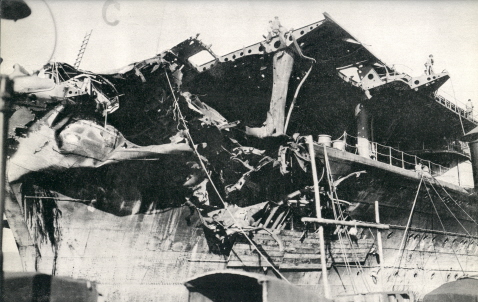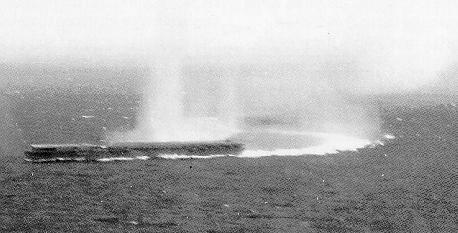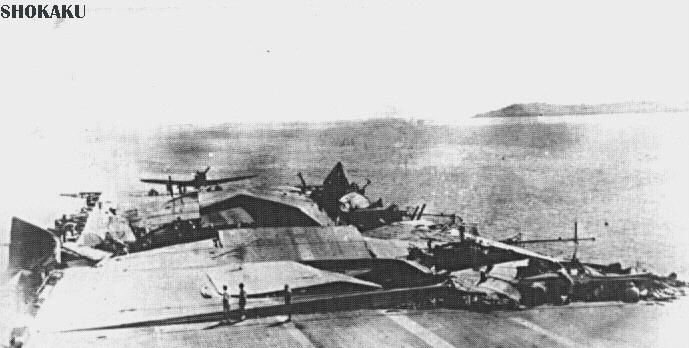Royal Alyskan Navy
Immortal class Gepantserde schip (battleship), 1914
Displacement
27,771 tons standard (as commissioned)
Speed
24 knots, 18 knot normal cruising, 24 knot battle speed
Range
8,000 nautical miles at 18 knots
Propulsion
24 watertube boilers, 4 turbines (mixture of Tetzenrozni and Isolder models) driving quadruple screws. Oil fired all ships.
Dimensions
187 metres long, 29 metres wide, 8 metres draught at full load
Armour
30 Centimeter belt thinning to 20 on ends, turrets protected by 30' front, 20' sides and barbettes protected by 30'. 30.5' conning tower with a 7.5' deck and numerous bulkheads providing underwater protection alongside some arrangement of the fuel oil tanks for added protection.
Armament
4x3 30.5 Centimeter guns, 18x1 10.0 Centimeter guns, 4x1 7.5 Centimeter anti aircraft guns, 2x1 saluting guns, provision for 6x1 35.0 centimeter torpedo tubes but never included in design. Armament changed considerably in refits, but present arrangement represents the ships as commissioned.
Ships
Zeus Laid down 15th April 1911, Launched 23rd March 1913, Commissioned 3rd July 1914
Poseidon Laid down 2nd June 1911, Launched 8th June 1913, Commissioned 15th October 1914
Venus Laid down 25th August 1911, Launched 29th June 1913, Commissioned 3rd March 1915
Athena Laid down 18th October 1911, Launched 11th October 1913, Commissioned 22nd May 1915
Mercury Laid down 13th March 1912, Launched 7th May 1914, Commissioned 17th September 1915
History
Development
The second Patagonian war in which the Royal Alyskan navy fought the combined navies of Argentina and Chile, and later Brazil following the abdication of the Emperor in 1908 represented the nations rise onto the level of a first tier naval power. Its exploits, particularly in the battle off Buenos Ares, storming of the Amazon delta and subsequent Amazon river campaign, earned it widespread acclaim and cemented the organizations reputation for being a hardfighting and modern force capable, and willing, of going toe to toe with forces equal to or greater than itself.
This reputation did not come without cost, namely the loss of five battleships, out of ten first and six second class units prewar. And the 1910 Treaty of Berlin that ended the war required Alyska to hand over its more obsolete ships to its vanquished foes, in the interests of peace (a stipulation largely put in at the behest of king Francis I to force updated naval construction to be approved but beyond the scope of this work) leaving the nation with just six battleships in service, though the planned Victory class dreadnoughts. were just beginning to enter service.
These battleships, and their large cruiser counterparts the Dauntless class, would form the beginnings of the 1910 naval law which when approved by the Assembly provided for the creation of a battlefleet consisting of eighteen capital ships, to be split between twelve battleships (the six surviving predreadnoughts being omitted) and eight large cruisers. However, these first classes of new construction showed several weaknesses, the use of compound engines for the Victory class and an outdated hexagonal arrangement of their main artillery being a primary issue, while the Dauntless class was seen as to lightly armed with just six 25.6 centimeter guns to be effective in her role. Thus the next classes of ship would have to be substantially reworked to be the equals of the ships entering service in foreign navies.
The first plan was to up gun the ships in accordance with the new super dreadnoughts being commissioned in foreign navies, however at the time nothing larger than the model 1907 30.5 centimeter BL gun existed beyond paper sketches. It was thus decided that this gun would have to do, though in larger numbers than those found on most other battleships, twelve guns preferably. The arrangement decided upon ultimately would feature four triple turrets arranged in two superfiring pairs fore an aft (a trimmed down variant mounting twin turrets in the same layout became the Chimera class battlecruisers) with the secondary battery also increased in caliber from 7.5 centimeter to 10.0 based on wartime experience showing the former weapons to be to lightweight against modern threats.
Four ships were initially planned, but curiously late in development the Imperial Chinese Navy requested that two ships of a similar design be built for its navy as part of its own attempt to modernize its fleet, after some deliberation the Ekaterina Naval dockyard accepted the contract and laid down two further ships in early 1912 for the Chinese fleet. The subsequent revolution in China and the collapse of the Emperors government in 1913 just after both ships were paid off led to the deal falling through however, and it was decided that one of the formerly Chinese ships would be completed for the Alyskan navy, becoming the Mercury.
Service
The ships entered service just as the first world war was breaking out and following the commissioning of all ships into the fleet in late 1915 all five ships were deployed to European waters as the Alyskan commitment to Neutrality enforcement patrols, which attempted to defend neutral shipping against both German submarines and the British blockade of Germany. With funnels repainted bright orange the ships began to patrol the English channel protecting convoys of Dutch, Spanish, Danish, Swedish and Alyskan ships. It was on one such mission that the Venus was torpedoed and sunk by the U-124, initial attempts to get the ship to Brest in France ended with the ship beaching herself on a sandback, before a fire reached the magazines and destroyed the ship with the loss of 213 of her crew.
Alyska immediately declared war on the German empire, Austro-Hungarian empire and Ottoman empire, assigning the four Immortals still afloat to the British Grand fleet, where they formed initially the sixth battle squadron, later fourth battlecruiser squadron due to their high speed. During the battle of the Skagerrak off the Danish coast in late 1916 the ships became isolated from the remainder of the Grand fleet when the battlecruiser force dispersed. The ships were found by the German battlecruisers and despite repeated radio request for assistance their messages failed to get through. The British battlecruiser flagship Lion having taken a hit to her bridge which had wounded all present (none killed) and cut off the ship from the remainder of the fleet, also crippling her steering. The ships nearest Lion had followed the drunken course of their flag, allowing the Alyskan ships to become isolated and exposed.
A total of five German ships soon found the range and began pummeling the Alyskans. Zeus took a total of sixteen confirmed hits, Poseidon eight, Athena (flag) thirty one and Mercury seven. The entire German High seas fleet was also entering range when elements of the third battlecruiser division, Dauntless and Fearless, the other Alyskan capital ships present for the battle, rushed in and began to draw the fire of the Germans, at the cost of the Fearless which disappeared under the gunfire of Derflinger and Lutzow. The Immortals then reformed with the rest of the battlecruiser fleet and chased the Germans into the waiting arms of the Grand fleets battleship squadrons, in the ensuing battle fought early the next morning the German navy lost six ships, with one further vessel foundering on the return trip to Germany. Against just four British losses (not counting Fearless) this represented a clear victory for Britain that buoyed morale at home.
The heavily damaged ships were refitted at British expense post battle and their gunnery lauded as highly effective, although outnumbered at times over five to one they had managed to give a good account of themselves, suffering no losses. The ships sat out the remainder of the war in the Grand fleets chief anchorage off Skapa flow, sortieing occasionally with other vessels in a futile attempt to lure out the surviving German battleships. Post was the ships returned to Alyska and were showered with honours, becoming then known as the immortal class for their seeming invulnerability to German shells.
The ships were however quite small compared to the new British, American and Japanese ships entering service and it was planned to build a new battlefleet, however the 1923 Washington Naval treaty largely put a stop to this, with the exception of the four Monarch class ships and the approval to build the two Admiraal class ships later in the 20s. The Immortals were maintained as the oldest elements of the fleet. Preserved, but seeing little service and largely kept in reserve as the cash strapped navy of the late twenties and early thirties spent what little money it had on completing the Admiraals and keeping the Monarchs up to date.
The 1930 London Naval conference, which put a premature end to the ten year battleship building holiday agreed to in 1923, saw plans made to scrap the Immortals. As the oldest ships in the fleet they were planned to make way for newer and more powerful battleships, what would become the Stuttland class of 1936. In preparation for this Zeus and Poseidon were scrapped between 1932 and 35 while Mercury and Athena were refit to serve as training ships, replacing older ships in that capacity. Following the collapse of the 1935 London conference with the revelation that the Japanese were constructing the Kii (45,000 tons and 4x2 45.72 guns) Athena and Mercury were refit starting in 1936, however Mercury would suffer a fire and be scrapped in 1937, leaving Athena to complete in 1938.
Some plans were made to sell the ship, with Chile and Spain both expressing interest. However the outbreak of the third Patagonian war in 1938 caused these plans to be delayed and the ship was used instead as a gunnery training and test ship by the navy. Training naval gun crews on the use of the latest optical and radar sighting devices for the ships main and secondary batteries, as well as AA guns. The ship sat out the war in the south, and the early battles of the Pacific war, playing no part in the East Indies campaign in which the Imperial Japanese navy sunk a large part of a combined Alyskan, British and Dutch fleet.
When Japan invaded the Alyskan mainland in 1943 Athena was in Posadka and quickly withdrawn to the south alongside the rest of the fleet when the Japanese menaced the city. The storms of October however rendered most aircraft incapable of operations and gave the Alyskans their chance. The battle of the Alyskan gulf, waged from the 10th until the 26th of October was the largest naval battle in history. Involving over a thousand ships. With both the main Alyskan and Japanese battlefleets engaging one another amidst difficult weather conditions. Athena was present for this, featuring modern fire control equipment and guns equivalent to the super cruisers used by both sides the ship had been shoehorned into the fleet which opposed the Japanese fleet.
Athena thus found herself once again isolated against the bulk of an enemy fleet. In this case the Japanese center forces first division, comprised of the Yamato and Shanano, both ships over twice her displacement. Knowing the futility of engaging the Japanese heavies with her own armament Athena instead attempted a ram against the Yamato. Which the ship did, ripping her own bow completely off and causing over five thousand tons of seawater to enter into the Japanese monster battleship. Ignored by the rest of the IJN the ships damage control parties saved the ship and, moving backwards in the water, she made it back to Posadka for an uncertain fate.
With Japans invasion, and their navy defeated there was little use for the ship, certainly not enough for the cost of the rebuilding. It was thus initially decided to scrap the ship. However, a mass public campaign organized by former crewmembers petitioned for the ship to be turned into a museum, as had been done with several of the navies former ships already. The government could not ignore the thousands of letters, but also did not have the money necessary to rebuild the ship. As a compromise a decision was halted until 1945, when the freshly victorious Alyskan government had the question of what to do with the ship decided for them.
King Titus (1936-1987) ordered the navy to restore the ship to the condition she had been in during her participation in the battle of Skagerrak, a lengthy and expensive task. But given the ships wrecked condition and generally poor material condition even restoring the ship to her appearance for her duel with Yamato would have been costly. Thus between 1947 and 1953 the ship was worked on tirelessly and opened to the public as the ceromonial flagship of the Alyskan navy.
The breakup of Alyska in the 1990s which culminated with the formal dissolution of the state in 2000 left the ships future in uncertain hands, the new United Provinces of America possessed the ship, queen Catherine II having ordered the ship to Novoya Amsterdam in 1999 just as the formal process for dissolving the kingdom became inevitable. However the Federal Republic of Alyska stated that ownership of the vessel belonged to them, as the successor and largest of the post kingdom nations, as well as the location where the ship had been built, it was only natural that the ship belonged to them. A ruling by the United States who attempted to mediate matters between the nations ceding ownership of Athena to the FRA was ignored and when the two nations went to war in 2004 the issue was put on hold, the conquest of the FRA and the declaration of the Federal Kingdom of Alyska in 2014 officially ended the dispute and today the ship is the flagship and Royal yacht of the Alyskan navy and Monarch.
This was way, way longer than I initially thought. But having just discovered this awesome thread I wanted to participate. I think I managed that.





